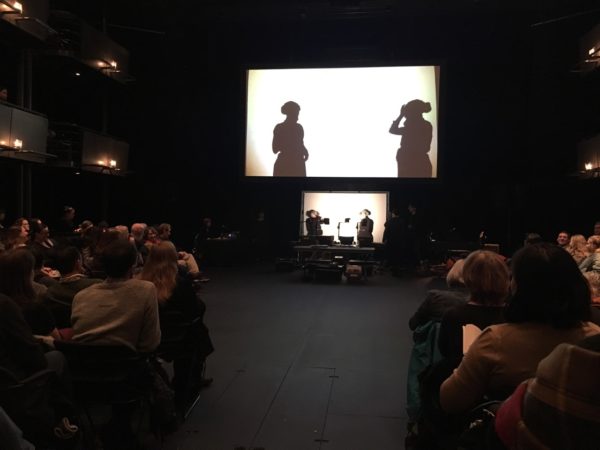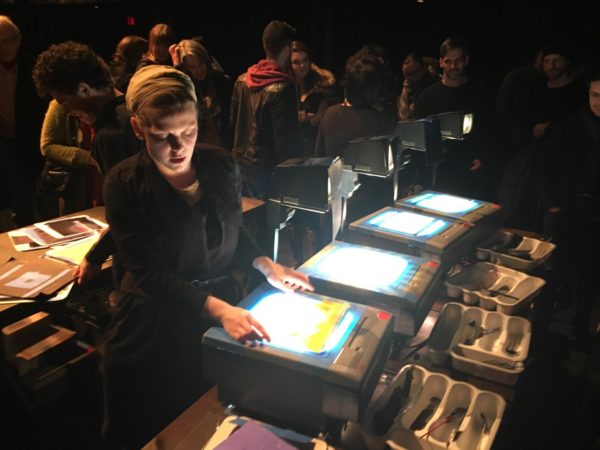
Manual Cinema's Ada|Ava, which just ended a one-night-only run at the Chan Centre, is an amazingly creative and unique production that almost defies description – but I'll try.
The show combines shadow projections of hand-cut, hand-drawn and photographic elements, plus live actors casting their own shadows, to create a sort of "live animated film". Add musicians and immersive, wraparound sound effects and you have something that's miles beyond any shadow-puppet show you've ever seen. It's a full-bodied screen tale, spooky, visually compelling, and emotional.
The company uses defiantly low-tech methods to achieve their amazing effects. A line of four old-school overhead projectors, straight out of a 70's high school's audio-visual club, are aimed away from the audience, pointed at a floor-level screen. One person operates each projector, constantly laying opaque and transparent elements into place, moving, sliding and animating them (some have movable parts) with exacting precision.
Two actors portraying the elderly twin sisters, Ada and Ava, appear between the projectors and the screen, and interact seamlessly with visual "props" and backgrounds that are merely shadows cast by the projectors.
Finally, behind that screen, a camera sends the (reversed) image up to a larger screen where it's easily visible to the audience. This is the only technical element that differentiates Ada|Ava from a shadow-puppet show that might have been performed in the 18th century or earlier.

Manual Theatre performers prepare for their presentation of "Ada|Ava".

After the show, the audience was invited to come over to view the equipment and props, ask questions, and take photos!
But what's on-screen feels both classic and very modern, thanks to some incredible visual techniques.They manage to bring all the tools of conventional cinema into play: long shots, closeups, "camera" movement, double-exposures... even flashbacks and dream sequences. All done without a word of dialogue, just visuals, sound, and music (including one of the most haunting and unusual versions of "In My Solitude" I've ever heard!).
All this technique would be for nothing, however, if there weren't a compelling story and characters. The two sisters gain our sympathy through the simplest of gestures, playing chess or clinking their teacups. They live next to a lighthouse, which they both help to maintain. Then one of them dies... and the other's grief is palpable as she stares at her reflection in the mirror or the empty chair on the other side of the chessboard. She flashes back to a childhood memory of the two of them visiting a carnival and fighting over a shell from the beach. Eventually, the surviving sister revisits the circus, and something bizarre happens inside the hall of mirrors... has her sister somehow returned?
Our ability to identify with shadows on a screen is never more clear than when the sisters are first reunited and embrace each other - it was a simple, powerful, emotional moment that brought tears to my eyes.
Every scene and screen of this one-hour tale is rich with gothic, stylized imagery that is not only beautiful, and sometimes terrifying, but constantly delights the audience with an awareness of how it is being created. Not only are the performers right in front of us, but many of the elements show clearly the layers of transparent film holding in place a waving arm, a nodding head, or a lost and drifting balloon. And all of this visible technique only makes the images on-screen that much more compelling.
References to Hitchcock, particularly Vertigo, abound - the twin sisters, the spiral stairs up to the lighthouse... I even spotted a reference to the McKittrick Hotel, where Jimmy Stewart spotted Kim Novak as "Madeline" in that classic film. But the feeling overall is more Edward Gorey - stylized, surreal and macabre with touches of black humour.
It's a shame that there was only one performance of Ada|Ava, but if you ever find yourself in a city where one of Manual Cinema's touring productions is playing, don't hesitate - go and experience it for yourself!